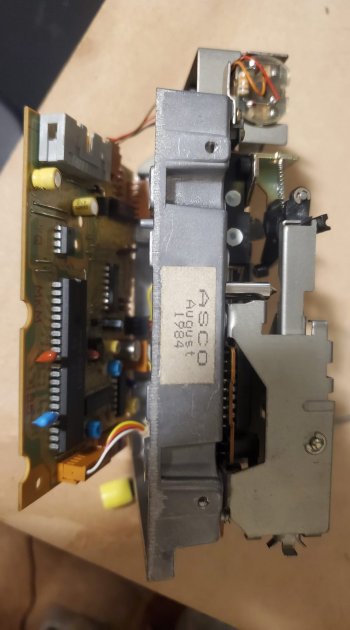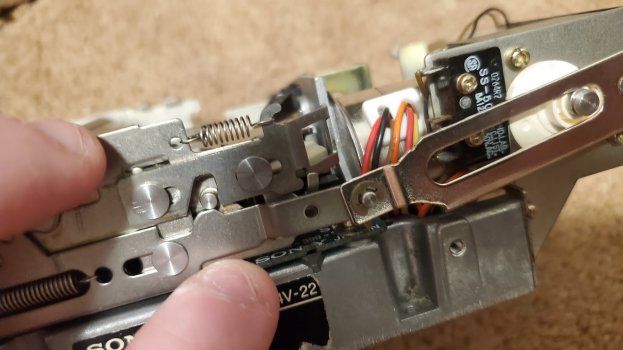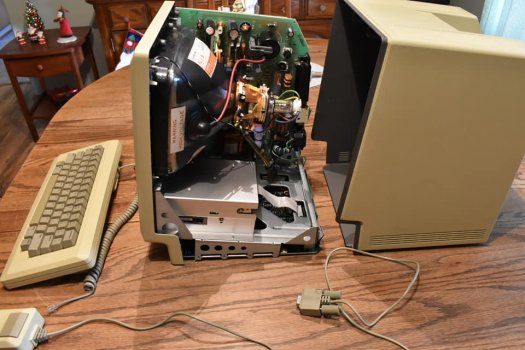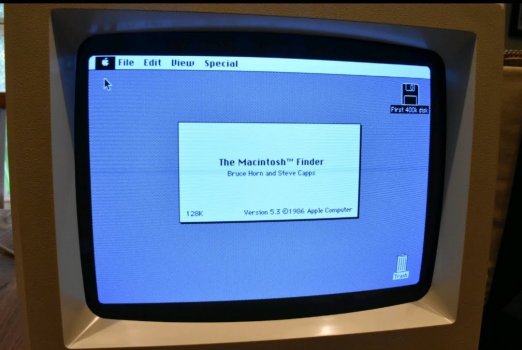Ok, I need some serious help with my 1984 Macintosh 128K Guys!!
I put this on a shelf for almost a year. Wishing it worked, but never being able to Re-align the 400k drive again. I am sad

To start off, A few years ago, I found this incredible condition 128K Macintosh set. All Factory stock, black Flyback cup, ect. Brand new condition bag, mouse, keyboard, everything!!
My dream, trophy Macintosh!!
It didn't read disks at all or was misaligned at first.
I also have some later Macintosh with 800k drives.
I made a 400K disk inside of one of those machines, and spent almost a entire day power cycling the 128K Macintosh, while moving the alignment PCB on the 400k by hair amounts using the disk made on the 800k drive.
By some amazing and incredible miracle, one of those attempts resulting is a perfectly aligned drive!! And I mean perfect.
The 400K read and wrote all disks from all the other machines absolutely perfectly for over 2+ years after that! I was happy

This lasted a long time. A year ago, I was doing some projects with a later Macintosh Classic drive to put more software on the 128K. Using the large drive going to the 800k, then into the 400K. U successfully got all the original 1984 software, like Macpaint, or the Demos onto some 400k floppies for the 128K
And while I was swapping disks, the 400k began throwing Read and Write errors. It still managed to boot, but had obviously became ever so slightly "misaligned" having some issues with many of the disks all of the sudden. Cleaning the head did nothing either.
So I made the dumb decision to loosen the Alignment screw AGAIN!!
Expecting myself to hit the lottery again
And guess what, It never worked since.

I need help aligning this drive. I'm so close for this Macintosh to be back at 100% perfect again!!
I do have an Oscilloscope I can use, but I don't know where to start with this drive. Is the drives head just a coil? Do I just probe the head?
Here are some pictures from yesterday I just took, and several from Years ago when the drive was aligned by sheer Luck.
I have the Macintosh ready for when I figure out the best way to go about doing this. I JUST REALLY NEED SOME HELP. THERE IS VERY LITTLE ABOUT THESE DRIVES ONLINE.

I put this on a shelf for almost a year. Wishing it worked, but never being able to Re-align the 400k drive again. I am sad

To start off, A few years ago, I found this incredible condition 128K Macintosh set. All Factory stock, black Flyback cup, ect. Brand new condition bag, mouse, keyboard, everything!!
My dream, trophy Macintosh!!
It didn't read disks at all or was misaligned at first.
I also have some later Macintosh with 800k drives.
I made a 400K disk inside of one of those machines, and spent almost a entire day power cycling the 128K Macintosh, while moving the alignment PCB on the 400k by hair amounts using the disk made on the 800k drive.
By some amazing and incredible miracle, one of those attempts resulting is a perfectly aligned drive!! And I mean perfect.
The 400K read and wrote all disks from all the other machines absolutely perfectly for over 2+ years after that! I was happy

This lasted a long time. A year ago, I was doing some projects with a later Macintosh Classic drive to put more software on the 128K. Using the large drive going to the 800k, then into the 400K. U successfully got all the original 1984 software, like Macpaint, or the Demos onto some 400k floppies for the 128K
And while I was swapping disks, the 400k began throwing Read and Write errors. It still managed to boot, but had obviously became ever so slightly "misaligned" having some issues with many of the disks all of the sudden. Cleaning the head did nothing either.
So I made the dumb decision to loosen the Alignment screw AGAIN!!
Expecting myself to hit the lottery again
And guess what, It never worked since.

I need help aligning this drive. I'm so close for this Macintosh to be back at 100% perfect again!!
I do have an Oscilloscope I can use, but I don't know where to start with this drive. Is the drives head just a coil? Do I just probe the head?
Here are some pictures from yesterday I just took, and several from Years ago when the drive was aligned by sheer Luck.
I have the Macintosh ready for when I figure out the best way to go about doing this. I JUST REALLY NEED SOME HELP. THERE IS VERY LITTLE ABOUT THESE DRIVES ONLINE.






